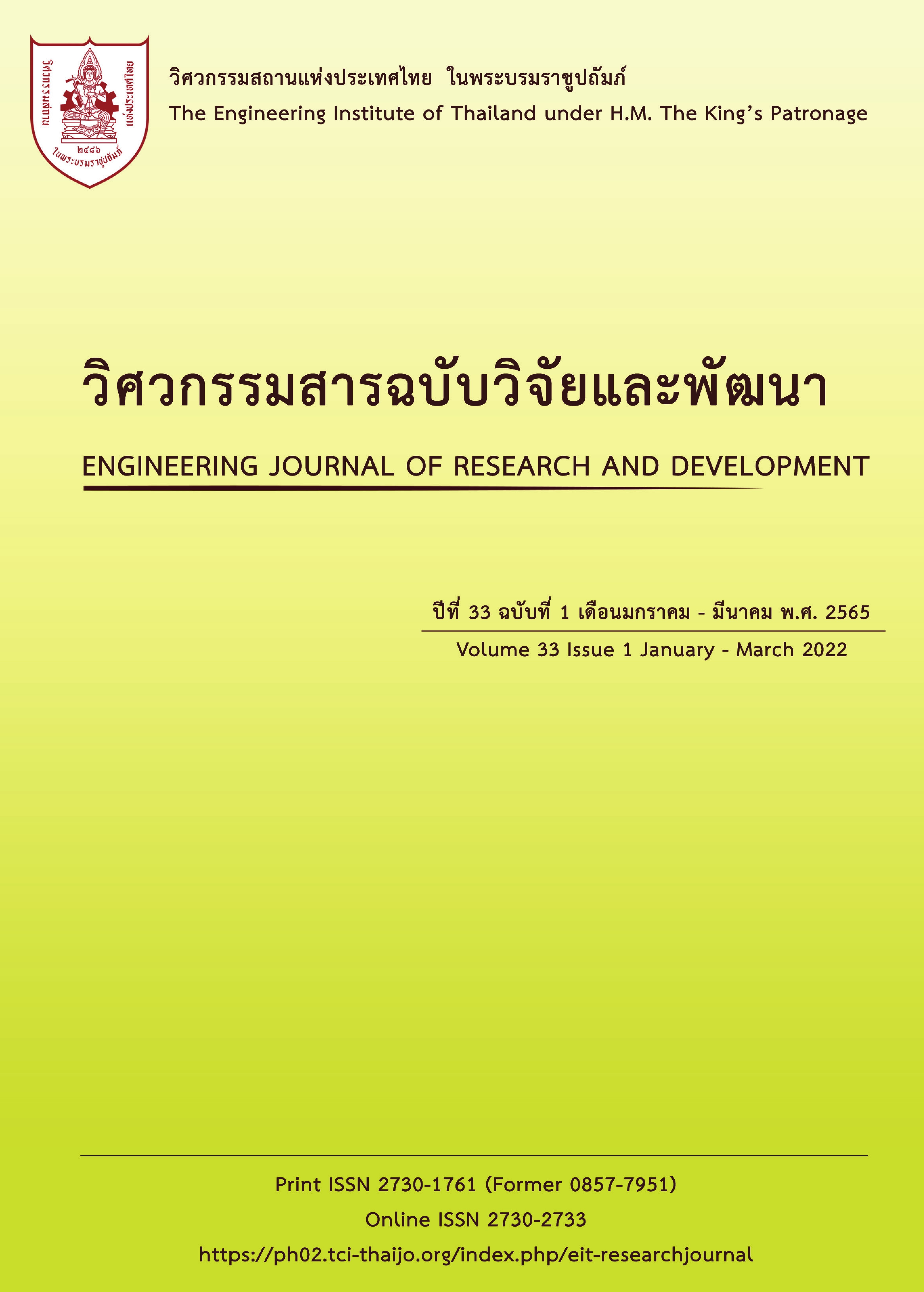EFFECT OF WET-DRY CONDITION ON COMPRESSIVE STRENGTH OF SOIL IMPROVEMENT WITH CEMENT AND FLY ASH-BASED GEOPOLYMER
Main Article Content
Abstract
At present, Ordinary Portland Cement has been widely used to improve the soil for highway base course. However, cement manufacturing process impacted on the environment. Geopolymer was chosen to replace the Ordinary Portland Cement for soil improvement in this research. This research was aimed to study the effect of wet-dry condition on unconfined compressive strength (UCS) of soil stabilized with Portland cement and fly ash-based geopolymer. Percentage of cement was 5 7 9 and 11 by mass and percentage of fly ash was 10 20 and 30 by mass. NaOH solution of 10 molar and various mix design at different fly ash/akali activator ratio and Na2SiO3/NaOH ratio were used to preparation specimens and cured for 2 7 and 28 days at room temperature. Each mixture was tested for UCS in accordant to the soil cement standard from the Portland Cement Association was used to perform wet-dry condition test. Wet-dry condition test was divided into 2 sets. The first set was used to conduct the UC test after through the process and the second set was determined the durability of the specimens. The results, revealed that the compressive strength of soil cement tended to decrease after processing and the mass loss percentage was 11.06. The unconfined compressive strength (UCS) of soil geopolymer tended to increase after the wet and dry condition and the mass loss percentage was 6.80. It was concluded that soil geopolymer exhibited the performance in withstanding the wet and dry condition better than soil cement.
Article Details

This work is licensed under a Creative Commons Attribution-NonCommercial-NoDerivatives 4.0 International License.
The published articles are copyright of the Engineering Journal of Research and Development, The Engineering Institute of Thailand Under H.M. The King's Patronage (EIT).
References
ธีระชาติ รื่นไกรฤกษ์ และ สุเชษฐ์ เอี่ยมเชย. รายงาน ฉบับที่ วว. 120 ความคงทนของดินซีเมนต์. กรุงเทพฯ: กรมทางหลวง สำนักวิจัยและพัฒนางานทาง, 2532.
อุบลลักษณ์ รัตนศักดิ์. วัสดุจีโอโพลิเมอร์. กรุงเทพฯ: สมาคมคอนกรีตแห่งประเทศไทย, 2560.
Ubolluk, R. and Prinya, C. Influence of NaOH solution on the synthesis of fly ash geopolymer. Mineral Engineering 22, 2009, 14. pp. 143-49.
ศราวุฒิ อภิเนตร และ เจริญชัย ฤทธิรุทธ. การปรับปรุงกำลังรับแรงอัดของดินลมหอบขอนแก่นด้วยจีโอโพลิเมอร์จากเถ้าลอยแคลเซียมสูง. การประชุมวิชาการวิศวกรรมศาสตร์ วิทยาศาสตร์ เทคโนโลยี และสถาปัตยกรรมศาสตร์ ครั้งที่ 8, มหาวิทยาลัยภาคตะวันออกเฉียงเหนือ, 21 กรกฎาคม 2560, pp. 28-34.
Phien-wej, N. et al. Collapse and strength characteristics of loess in Thailand. Engineering Geology, 1992, 32, pp. 59-72.
Muhammad, SA. and Fauziah, A. Effect of Alkaline Activator to Fly Ash Ratio for Geopolymer Stabilized Soil. MATEC Web of Conferences, 2017, 97, pp. 1-8. DOI: 10.1051/matecconf/20179701012.
จิระยุทธ สืบสุข และ อัครเดช ศิริพันธุ์. ผลของวัฏจักรเปียกสลับแห้งต่อกำลังของวัสดุพื้นทางดินลูกรังปรับปรุงด้วยซีเมนต์.
วารสารวิศวกรรมศาสตร์ มหาวิทยาลัยเชียงใหม่, 2017, 24 (3), pp. 142-49.
American Society for Testing and Materials. ASTM Standard D559. Wetting and Drying Compacted Soil-Cement Mixtures. West Conshohocken, PA, USA, 2003.
American Society for Testing and Materials. ASTM Standard D1557. Standard Test Methods for Laboratory Compaction Characteristics of Soil Using Modified Effort (56,000 ft-lbf/ft3(2,700 kN-m/m3)). West Conshohocken, PA, USA, 2007.
American Society for Testing and Materials. ASTM Standard C618. Standard Specification for Coal Fly Ash and Raw or Calcined Natural Pozzolan for Use in Concrete. West Conshohocken, PA, USA, 2019.
American Society for Testing and Materials. ASTM Standard D2166. Standard Test Method for Unconfined Compressive Strength of Cohesive Soil. West Conshohocken, PA, USA, 2013.
กรมทางหลวง. ทล.-ม. 204/2556: 2556. มาตรฐานงานพื้นทางดินซีเมนต์ (Soil Cement Base). กรุงเทพฯ: ศูนย์วิเคราะห์และตรวจสอบ กรมทางหลวง กระทรวงคมนาคม, 2556.


